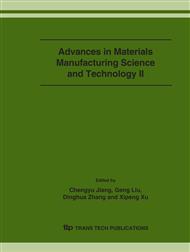p.937
p.941
p.945
p.949
p.953
p.957
p.961
p.965
p.969
Numerical Simulation of Heat and Mass Transfer of the Infiltration in Liquid Infiltration Extrusion Process
Abstract:
The pressure infiltration process of porous preforms by molten metals was investigated numerically in this paper. The finite element model of heat and mass transfer of the infiltration in liquid infiltration extrusion process was founded by the introduction of a new continuum model of fluid in porous medium and a distribution resistance concept. The proposed model can describe the transient flow behavior of semisolid materials qualitatively. Numerical simulations were developed in particular for non-isothermal infiltrations which take into account the thermal aspects (the mould, the fibres and the metal are initially preheated at different temperatures). The temperature distribution, infiltration front and infiltration depth in the infiltration area were gained by the simulation of ANSYS/FLOTRAN code. It is shown that the fiber volume fraction and initial temperature have a strong effect on the infiltration process. The simulation results of axisymmetric infiltration have a good agreement with their experimental ones. In addition, the infiltration time was predicted to get the effective infiltration depth based on the simulation results.
Info:
Periodical:
Pages:
953-956
Citation:
Online since:
December 2006
Authors:
Price:
Сopyright:
© 2006 Trans Tech Publications Ltd. All Rights Reserved
Share:
Citation:


